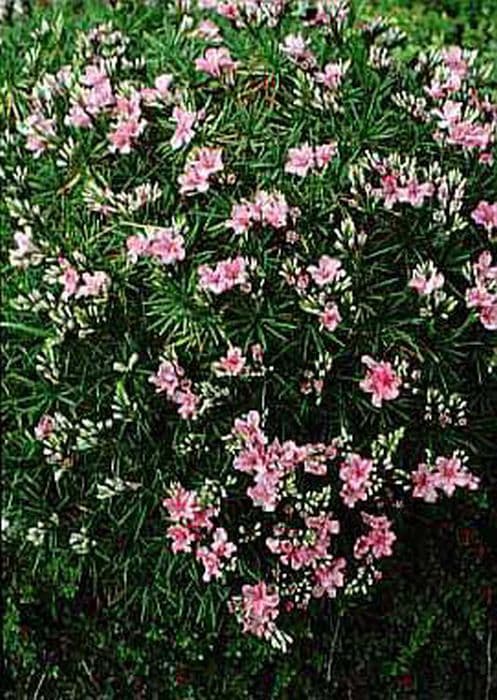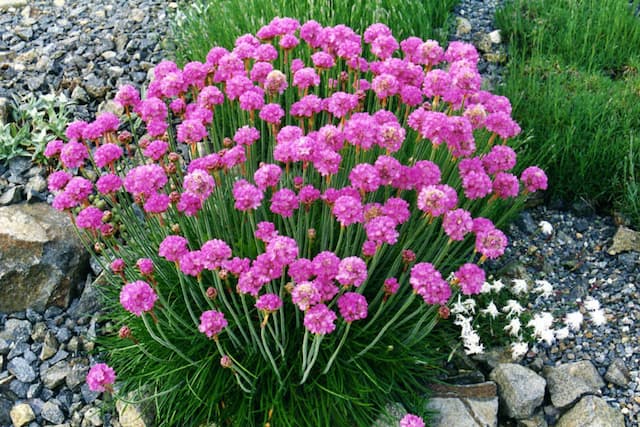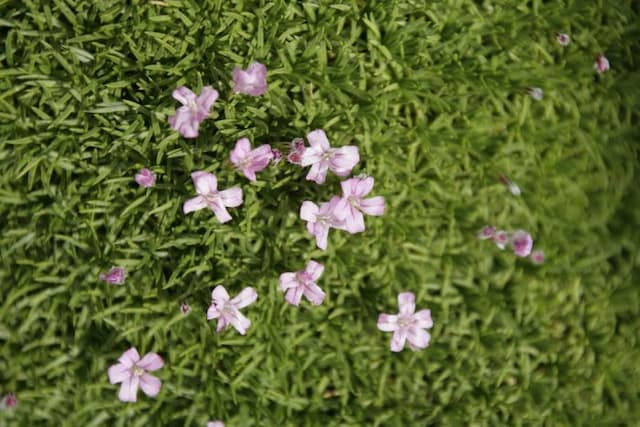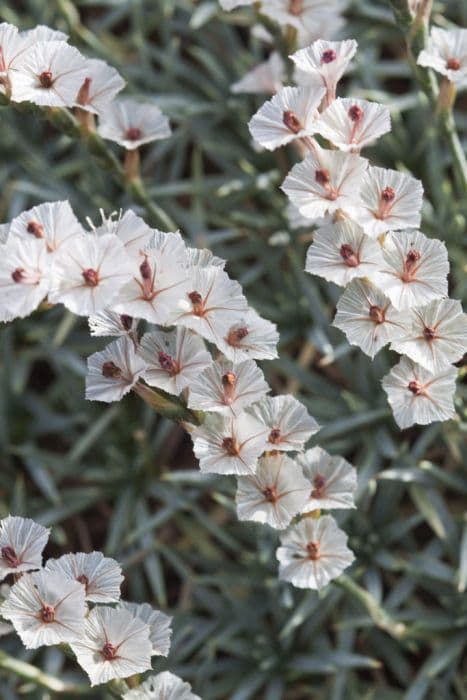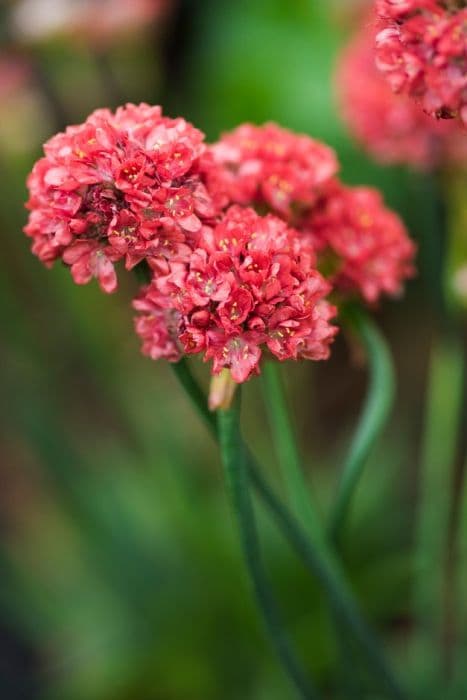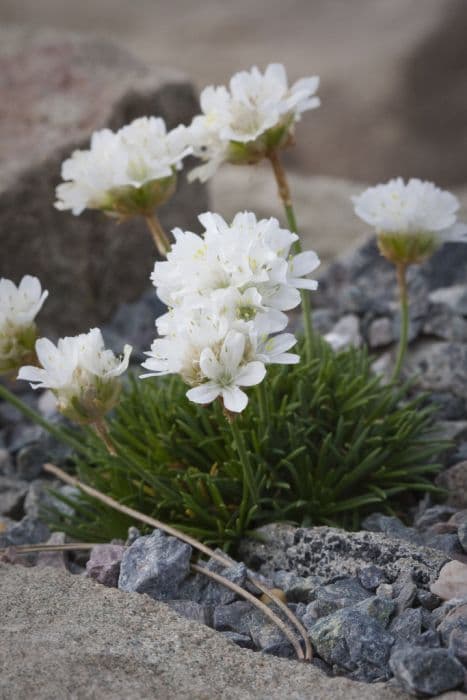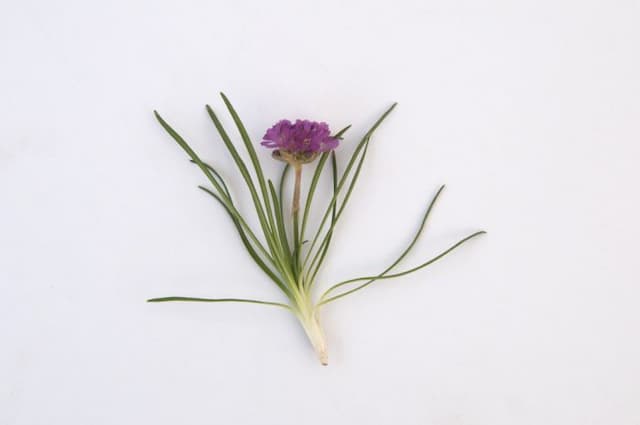Pink Flamingo Feather Psylliostachys suworowii

ABOUT
Commonly known as the Russian Statice, Psylliostachys suworowii is a striking ornamental plant that is recognized for its unique floral display. This plant features numerous slender, wiry stems that are covered in narrow, lance-shaped leaves. The foliage typically sports a blue-green hue, creating a soft, fine-textured backdrop for the blooms. The most distinct characteristic of the Russian Statice is its flowers. They are arranged in long, narrow, tapering spikes that resemble feathery plumes, adding a delicate and airy feel to the overall appearance of the plant. These blossoms come in an array of pink and lavender shades, resembling small, papery bells that give the plant a whimsical and frothy look. As the flowers mature, they can take on a papery texture, further enhancing their visual appeal and making them a popular choice for dried floral arrangements. While in bloom, the Russian Statice lends a burst of color and an almost ethereal quality to gardens and flower arrangements. Its flowers are densely packed along the spikes, creating a showy and elongated inflorescence that stands out against the foliage. The visual impact of its flowers makes it an excellent choice for adding a touch of whimsy and color to any planting space. The Russian Statice's blend of delicate flowers and fine foliage contributes to its popularity among gardeners who value plants with both textural and visual interest, albeit without considering its specific dimensions.
About this plant
 Names
NamesFamily
Plumbaginaceae
Synonyms
Russian Statice, Rat Tail Statice, Pink Pokers, Suworow's Statice
Common names
Goniolimon suworowii, Statice gmelinii, Statice suworowii
 Toxicity
ToxicityTo humans
Psylliostachys suworowii, commonly known as Russian statice, is not widely considered to be toxic to humans. However, as with any plant, individual allergic reactions or sensitivities may occur. If ingested in large amounts, it could potentially cause stomach discomfort or other digestive symptoms due to the plant's non-food nature. It is always advisable to avoid eating ornamental plants and to keep them out of reach of small children who may ingest them out of curiosity.
To pets
Russian statice is not commonly listed as toxic to pets such as dogs and cats. Pets may sometimes nibble on plants out of curiosity or boredom, which could lead to mild gastrointestinal upset, but there are no specific toxins in Russian statice known to cause severe poisoning in pets. Nonetheless, it is generally recommended to prevent pets from ingesting plants to avoid any potential issues. If a pet does consume Russian statice and shows signs of distress, contacting a veterinarian is recommended.
 Characteristics
CharacteristicsLife cycle
Annuals
Foliage type
Deciduous
Color of leaves
Green
Flower color
Pink
Height
2-3 feet (60-90 cm)
Spread
1-2 feet (30-60 cm)
Plant type
Herb
Hardiness zones
8
Native area
Central Asia
Benefits
 General Benefits
General Benefits- Ornamental Value: Psylliostachys suworowii, commonly known as Russian Statice, is appreciated for its showy, pink to lavender flower spikes, adding color and visual interest to gardens and landscapes.
- Drought Tolerance: Russian Statice is known for its ability to withstand dry conditions, making it suitable for xeriscaping and water-wise gardening.
- Salt Tolerance: This plant can tolerate saline soils, which is beneficial for coastal areas where other plants may struggle to survive.
- Low Maintenance: Russian Statice requires minimal care once established, making it a good choice for gardeners with limited time or those new to gardening.
- Attracts Pollinators: The blooms of Russian Statice are attractive to bees, butterflies, and other beneficial insects, helping to support local ecosystems.
- Cut Flowers: The long-lasting flowers and stems are ideal for fresh floral arrangements and are commonly used in the cut flower industry.
- Dried Arrangements: Flowers of Russian Statice retain their color and shape when dried, making them popular for crafts, dried flower arrangements, and everlasting bouquets.
- Soil Erosion Control: This plant's root system helps to stabilize soil, reducing erosion in sandy and coastal regions.
- Versatility: Russian Statice can be grown in flower beds, rock gardens, containers, and as border plants, offering flexibility in garden design.
- Fast Growth: It is a fast-growing plant that can quickly fill in garden spaces and provide a full, lush look.
 Medical Properties
Medical PropertiesThis plant is not used for medical purposes.
 Air-purifying Qualities
Air-purifying QualitiesThis plant is not specifically known for air purifying qualities.
 Other Uses
Other Uses- Landscape design: The airy sprays of pink flowers of the Russian Statice are often used in xeriscaping, a landscaping approach that utilizes drought-tolerant plants to reduce the need for irrigation.
- Crafts: Dried flowers of the Russian Statice can be used in crafting, such as in the creation of natural wreaths, dried flower arrangements, or potpourri mixtures.
- Eco-printing: The colorful flowers can be used in eco-printing, a technique where plants are used to transfer colors and patterns onto fabric or paper.
- Dye: The pigments in Russian Statice can be used to produce a natural dye for textiles, offering a range of hues from soft pinks to rich lavenders.
- Education: Russian Statice can serve as an educational tool in botany or horticulture classes, demonstrating plant growth, pollination, and xerophytic adaptations.
- Photography: With its striking bloom spikes, Russian Statice is often photographed and used in nature and garden photography portfolios.
- Festive decorations: Around certain holidays, Russian Statice can be used to create festive decorations due to its bright and cheerful flowers.
- Floral crafts: The stems can be woven or braided into floral crafts and decorative accessories like headbands or bracelets.
- Companion planting: Russian Statice can be planted alongside other drought-tolerant species to create a supportive micro-environment for each plant.
- Hummingbird attraction: While not a primary use, Russian Statice can be part of a garden designed to attract hummingbirds, who are drawn to the bright flowers.
Interesting Facts
 Feng Shui
Feng ShuiThe Russian Statice is not used in Feng Shui practice.
 Zodiac Sign Compitability
Zodiac Sign CompitabilityThe Russian Statice is not used in astrology practice.
 Plant Symbolism
Plant Symbolism- Uniqueness: With its distinctive spiraled spikes and colorful blossoms, the Pink Mist, as Psylliostachys suworowii is commonly known, symbolizes individuality and a stand-out personality.
- Elegance: The delicate and fine structure of the Pink Mist's blooms represents grace and refinement.
- Charm: Pink Mist's gentle pink hue and its enchanting floral arrangements are reminiscent of charm and beauty.
- Whimsy: The unusual and playful shape of the flowers of Pink Mist lends itself to symbolism connected with fun and a whimsical nature.
- Rarity: Owing to its less common occurrence, Pink Mist can symbolize rarity and the value of scarce beauty.
 Water
WaterFor Russian sage (Psylliostachys suworowii), moderate watering is recommended. The plant prefers to have consistently moist soil, but it's important to avoid overwatering as it does not tolerate soggy conditions. Typically, watering once a week with approximately 1 to 1.5 gallons should suffice. During periods of extreme heat or drought, additional watering may be necessary. Conversely, during cooler months or when rainfall is abundant, reduce the frequency of watering to prevent root rot.
 Light
LightRussian sage thrives in full sun conditions, meaning it should receive at least six hours of direct sunlight each day. The best spot for the plant is an area where it can bask in unfiltered sunlight throughout the majority of the day. These lighting conditions promote healthy growth and abundant flowering.
 Temperature
TemperatureRussian sage does well in a wide range of temperatures but prefers a moderate climate. The plant can survive minimum temperatures in the range of 20 to 30 degrees Fahrenheit but might die back to the ground in freezing conditions, emerging anew in spring. Ideal growing conditions are between 60 and 75 degrees Fahrenheit, but it can also tolerate high temperatures as long as it is well-watered.
 Pruning
PruningPruning Russian sage helps maintain its shape and encourages more vigorous growth. It's best to prune in early spring just as new growth begins. You can cut back the previous year's growth by about one-third to promote a bushier plant. Pruning can be done up to twice a year, in spring and after the first flush of flowers, to encourage a second bloom.
 Cleaning
CleaningAs needed
 Soil
SoilRussian Sage's best soil mix is light, well-draining with plenty of sand or perlite, and a pH of 6.0 to 7.0.
 Repotting
RepottingRussian Sage should be repotted every 2-3 years to refresh the soil and accommodate root growth.
 Humidity & Misting
Humidity & MistingRussian Sage prefers a dry environment with low to average humidity levels for optimal growth.
 Suitable locations
Suitable locationsIndoor
Provide full sun, well-draining soil, and minimal water for Russian Sage.
Outdoor
Plant in full sun, sandy soil, and water sparingly for Russian Sage.
Hardiness zone
4-9 USDA
 Life cycle
Life cyclePsylliostachys suworowii, commonly known as Russian Statice, begins its life cycle as a seed that, when sown, germinates within a couple of weeks in the right conditions. Upon germination, the seedling emerges, developing a rosette of lance-shaped leaves. As it grows, Russian Statice enters the vegetative stage, producing stems and more leaves, and becomes ready to withstand transplanting if necessary. The plant then reaches the flowering stage, usually in the summer months, where it produces tall spikes adorned with tiny pink or lavender flowers that give it a feathery appearance. After pollination, which can occur via wind or insects, the plant sets seeds that mature, dry, and can be collected for future propagation or allowed to self-sow. Eventually, as temperatures drop or growing conditions become unfavorable, Russian Statice will complete its life cycle, potentially dying back if it is in a region with cold winters, or may persist as a perennial in milder climates.
 Propogation
PropogationPropogation time
Spring
Propogation: Psylliostachys suworowii, commonly known as Russian Statice, is often propagated by seed. The ideal time to sow Russian Statice seeds is in late winter to early spring, directly into the soil where they will grow or in seed trays for later transplanting. To propagate, one would scatter the seeds on the surface of well-drained, light soil, barely covering them with a fine layer of earth or vermiculite. The seeds need a fair amount of light to germinate, so it’s important not to bury them too deeply. Seedlings usually emerge in 14 to 21 days at a temperature around 70 degrees Fahrenheit (21 degrees Celsius), after which they can be thinned and eventually transplanted outdoors following the last frost. Keeping the soil consistently moist during the germination period is critical but should be reduced once the seedlings are established to prevent root rot.
